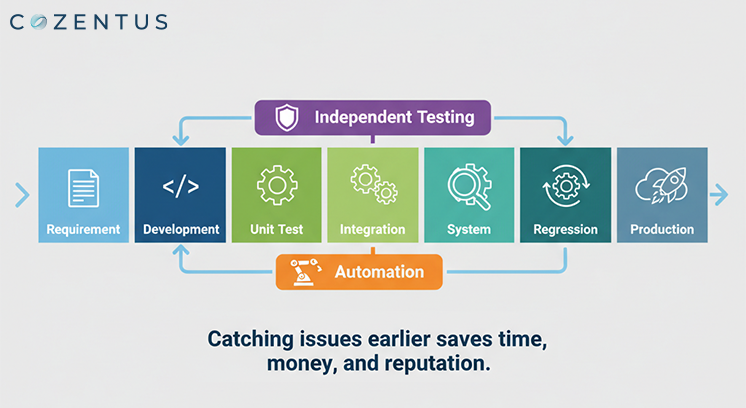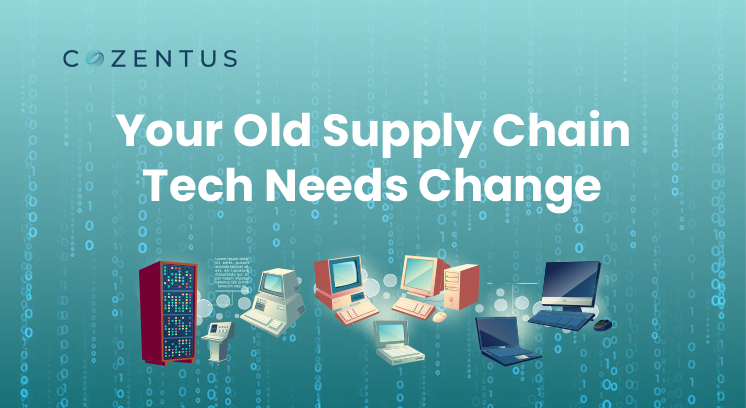The Calm Before the Storm
You’ve heard it before - “Our testing is solid.”
Every team says it. Every manager believes it. But then release day arrives.
And suddenly, the system behaves differently in production. Dashboards freeze. Data doesn’t sync. Customer portals time out. Support calls start flooding in.
That’s when reality hits: “We thought our testing had it covered.”
The truth is that most organizations aren’t short on testing efforts - they’re short on testing depth, independence, and structure.
We see this story repeat itself across industries. From logistics platforms managing real-time shipments to financial systems processing thousands of transactions every second. The problem isn’t about not testing enough. It’s about testing the right way.

Confidence Can Be Misleading in Testing
Teams often fall into what we call the “confidence trap.”
When the same developers write the code, design the test cases, and execute the validation, blind spots can happen. Everything seems fine — until production says otherwise.
Here’s why:
- Developers test for what they expect to happen, not what can happen.
- Business users focus on functional flow but overlook gaps in integration.
- Test coverage looks good on paper, but risk coverage is poor in practice.
This overconfidence isn’t arrogance. It’s human nature.
People trust what they build. But trust doesn’t replace the discipline of testing.
The Real Value of Independent Testing
Independent testing brings a fresh pair of eyes, detached from assumptions and internal bias.
When testing is handled by an independent, specialized team (like Cozentus’ Quality Engineering practice), you don’t just validate the software - you validate its readiness for business.
Independent testing helps you:
- Detect integration issues early
- Challenge user journeys under real conditions
- Test scalability, data integrity, and resilience
- Ensure systems behave consistently across environments
In high-stakes industries like logistics, this independence becomes even more critical. When your platform manages thousands of shipments or invoices daily, a single unnoticed defect can lead to delayed deliveries, financial losses, or customer dissatisfaction.
That’s not a “testing issue.” That’s a business impact issue.
Structured Testing Saves You on Release Day
Many teams think of testing as a checklist before release. But structured testing is about building confidence through methodical validation.
At Cozentus, we emphasize a layered approach:
- Unit and Integration Testing: Ensure components communicate correctly.
- System and Regression Testing: Validate workflows across end-to-end business scenarios.
- Performance and Load Testing: Confirm stability under real-world stress.
- Automation Testing: Reduce cycle time and improve accuracy across frequent releases.
- User Acceptance & Business Testing: Validate outcomes against actual business expectations.
When these layers work together, they form a safety net and a shield of assurance.
Automation Is a Tool - Not a Shortcut
Automation has revolutionized testing, but it’s not magic. Automating broken test cases only increases wrong results.
The real power lies in smart automation frameworks that understand change, adapt quickly, and validate intelligently.
Cozentus builds automation around reusable assets, modular design, and continuous integration. Our frameworks ensure that every new build is validated automatically. This helps in freeing the teams to focus on high-value exception handling instead of repetitive validation.
For logistics systems, this is especially valuable. When you have multiple integrations (like shipment visibility platforms, ERP, carrier systems, and analytics dashboards), automation ensures consistency across dynamic data flows. It makes sure that when you roll out new features, operations don’t stop.

Performance Testing is The Silent Hero
One of the biggest reasons releases break isn’t functionality - it’s performance.
A system can pass all test cases in staging and still fail under live conditions. Why? Because production data behaves differently. User volume spikes. APIs time out. Queues clog.
That’s where structured performance testing comes in. It simulates real-world load conditions and monitors system behavior under stress. Our goal isn’t just to “see if it works” — it’s to ensure it won’t fail when it matters most.
Think of a logistics control tower managing thousands of concurrent shipment updates. A few seconds of delay in API response can disrupt operations across carriers, customers, and SLAs. Performance assurance isn’t optional - it’s mandatory.
The Cost of Ignoring Independent Testing
Let’s look at the math. The cost of fixing a defect found in:
- Development: $100
- Testing: $1,000
- Production: $10,000+ (plus reputational damage)
When systems go live with undetected defects, it’s not just about money - it’s about trust. Customers lose confidence. Operations lose time. Teams lose credibility.
Independent testing is your insurance against this. It makes sure quality is built in from the start, not added later.
What Businesses Should Get from Testing
Testing isn’t just about catching defects. It’s about building trust in every release.
When every release, patch, and integration follows a structured validation process, your business gains confidence to scale faster and innovate without fear.
Cozentus helps organizations achieve this through:
- Test Advisory & Maturity Assessment: Identifying gaps and creating a roadmap to optimize QA processes.
- End-to-End Functional & Automation Testing: Reducing manual workload and increasing the speed of validation cycles.
- Performance & Security Testing: Ensuring stability, reliability, and data protection.
- Independent Validation & Verification (IV&V): Providing a clear, unbiased check on your most important systems.
We don’t just “test software.” We help clients build reliability into their ecosystem - from freight audit platforms to financial applications.
You might like this: Why Outsource Testing for Supply Chain Operations?
The Cozentus Advantage
Our testing philosophy blends deep domain expertise with modern automation practices.
For logistics and supply chain businesses, that means validating:
- Real-time data synchronization between carrier systems and platforms
- Freight invoice reconciliation and matching accuracy
- API reliability between TMS, ERP, and analytics systems
- End-to-end visibility dashboards functioning seamlessly across regions
For enterprises across other sectors, it means:
- Faster releases
- Lower defect leakage
- Higher customer satisfaction
Conclusion: Make Sure Your Release Can Be Trusted
When the next release is ready to go live, ask yourself: “Are we truly confident or just comfortable?”
Because when systems are critical, comfort is costly. Independent, structured testing doesn’t just save time or money; it saves your reputation. We help organizations move from last-minute testing to building quality from the start.
After all, it’s easy to say, “We’ve got testing covered.” The real question is: will your release agree?
Want to prevent costly release failures? Let’s talk
.Recent Post
Subscribe to our newsletter
Stay updated on latest trends and news in the supply chain and logistics industry







